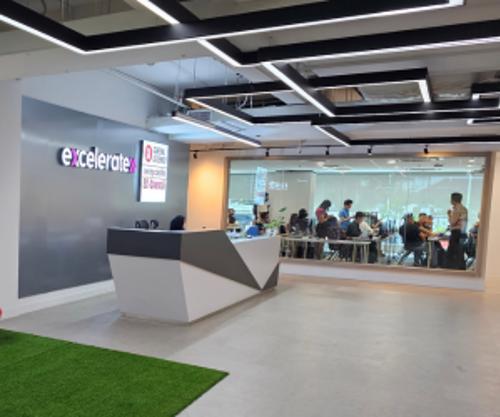

UX Design
Expand your organisation’s competitive edge with more innovative and effective user experiences. Understand key principles of UX, from user personas to wireframing to prototyping - all elements that will impact how much users love and engage with your product. Ensure long-term business success and invest by crafting a team versed in tailoring experiences to boost customer satisfaction.
A positive user experience can increase customer satisfaction, improve brand loyalty, and ultimately drive revenue growth.
Enhanced customer satisfaction
UX design skills can help organisations create interfaces that are user-friendly, intuitive, and easy to navigate. Positive user experience does improved customer satisfaction and loyalty, as customers are more likely to return to businesses.
Increased innovation
UX designers are trained to focus on user research and testing, that helps businesses identify unmet needs and develop innovative solutions. Organisations that tap into their these individuals' creativity and problem-solving abilities to drive innovation and differentiation in the marketplace.
Competitive advantage
Meeting the ever-evolving needs of customers with a well-designed user experience can be a significant competitive advantage. Happy customers are more likely to become repeat customers and recommend the business to others.
UX Design Bootcamp
Overview:
Prerequisites:
This is a beginner-friendly program with no prerequisites, although many learners are familiar with digital design concepts.
Ideal for:
Those new to the field or just looking to formalise your practice, our curriculum helps learners gain fluency in end-to-end UX processes, tools, and documentation and put them to work for you, your
organisation, and your career.
Outcomes:
- Effective user research and personas.
- Thoughtful task analysis, user flows, and navigation.
- A full set of wireframes with clear annotation and attention to detail.
- A portfolio-ready design and project demo.
Course Outline
• Get acquainted with the course and expectations.
• Discuss the discipline of UX design and the design process.
• Explain why user research is important in the UX design process.
• Describe various user research methods.
• Determine when user interviews are beneficial to the design process.
• Practice conducting user interviews and writing problem statements.
• Explain the importance and purpose of synthesizing research in UX design.
• Use affinity mapping to identify insights and actionable steps.
• Create personas and user scenarios based on synthesized research insights.
• Explain why user research is important in the UX design process.
• Describe various user research methods.
• Determine when user interviews are beneficial to the design process.
• Practice conducting user interviews and writing problem statements.
• Explain the importance and purpose of synthesizing research in UX design.
• Use affinity mapping to identify insights and actionable steps.
• Create personas and user scenarios based on synthesized research insights.
• Explain why user research is important in the UX design process.
• Describe various user research methods.
• Determine when user interviews are beneficial to the design process.
• Practice conducting user interviews and writing problem statements.
• Explain the importance and purpose of synthesizing research in UX design.
• Use affinity mapping to identify insights and actionable steps.
• Create personas and user scenarios based on synthesized research insights.
• Explain why user research is important in the UX design process.
• Describe various user research methods.
• Determine when user interviews are beneficial to the design process.
• Practice conducting user interviews and writing problem statements.
• Explain the importance and purpose of synthesizing research in UX design.
• Use affinity mapping to identify insights and actionable steps.
• Create personas and user scenarios based on synthesized research insights.
• Explain why user research is important in the UX design process.
• Describe various user research methods.
• Determine when user interviews are beneficial to the design process.
• Practice conducting user interviews and writing problem statements.
• Explain the importance and purpose of synthesizing research in UX design.
• Use affinity mapping to identify insights and actionable steps.
• Create personas and user scenarios based on synthesized research insights.
• Explain why user research is important in the UX design process.
• Describe various user research methods.
• Determine when user interviews are beneficial to the design process.
• Practice conducting user interviews and writing problem statements.
• Explain the importance and purpose of synthesizing research in UX design.
• Use affinity mapping to identify insights and actionable steps.
• Create personas and user scenarios based on synthesized research insights.
• Explain why user research is important in the UX design process.
• Describe various user research methods.
• Determine when user interviews are beneficial to the design process.
• Practice conducting user interviews and writing problem statements.
• Explain the importance and purpose of synthesizing research in UX design.
• Use affinity mapping to identify insights and actionable steps.
• Create personas and user scenarios based on synthesized research insights.
• Analyze brand personalities.
• Create the artifacts of a personal brand.
• Describe what portfolios are and their purpose in the industry.
• Outline a case study to support a portfolio.
• Determine the audience and usability of a UX portfolio.
• Discuss portfolio site-builder and hosting options.
• Present the decision-making process of your design work.
• Provide and receive feedback and suggestions for improvement.
UX Design Immersive
Overview:
Prerequisites:
This is a beginner-friendly program with no prerequisites, although many learners are familiar with common tools for graphic and web designers and some may have had exposure to UX concepts in the past.
Ideal for:
Those wanting a career transformation. We see career-changers from diverse professional backgrounds like graphic design, UI design, architecture, and marketing, as well as more far-flung fields like psychology and anthropology.
Outcomes:
Graduates will have a professional-grade capstone project that showcases how to design digital experiences that power revenue, user loyalty, and product success.
Course Outline
• Getting started in UX
• The UX design process
• Conducting user research
• Competitive analysis
• Affinity mapping
• Creating personas
• Defining your users’ problem
• Information architecture
• Designing intuitive navigation
• Identifying problems and needs
• Planning, executing, and synthesizing
user interviews
• Refining and confirming assumptions
• Hand sketching
• Rapid prototyping
• Essentials of usability testing
• An introduction to presentations
Project Example: Create the foundation of an app through a lean UX process of rapid prototyping and ideation. This project immediately introduces the range of skills required in the UX field and helps you build a low-fidelity prototype.
• Contextual and comparative inquiry
• Competitive analysis
• Information architecture
• Navigation and sitemaps
• Web layouts and wireframes
• Interaction design principles
• Visual design: typography, color theory, and composition
• Responsive design
• Accessibility
• Building UI components
Project Example: Design a clickable prototype for an
online shopping experience that meets the goals of the
users, the business, and the brand.
• Project management and planning
• Design studio brainstorming
• Advanced testing and research
• Feature prioritization and integration
• Group facilitation
• Design iterations
• UX writing
• Content strategy
• Designing for the future: VR, AR, and wearables
• Team presentations
• Creating a research report and specifications document
Project Example: Work in teams to design a new
feature for an existing product or brand in order to
meet a business goal. Complete the entire design
process, including user research, feature prioritization,
sketching, wireframing, prototyping, and testing.
• Product pitching
• Product management
• Sprint planning
• Agile development methodology
• Technology constraints
• HTML and CSS
• Objectives and key results (OKRs) and key performance indicators (KPIs)
• Advanced prototypes
• Storytelling and stakeholder presentations
Project Example: Create a website, utilizing visual design (e.g., color, type, composition, and layout) and storytelling techniques to showcase your work and portfolio.
• Client management
• Project management
• Product management
• Balancing business and user goals
• Managing clients and stakeholders
Project Example: Collaborate directly with external clients to create a brand-new feature or improve an existing one. Experience working with a diverse range of stakeholders to solve real business problems.
• Client management
• Project management
• Product management
• Balancing business and user goals
• Managing clients and stakeholders
Project Example: Collaborate directly with external clients to create a brand-new feature or improve an existing one. Experience working with a diverse range of stakeholders to solve real business problems.
Prefer personalised consultation on corporate training?
AKADEMI GA
is an exclusive partner of General Assembly (GA) in Malaysia. Akademi GA is now a member of the Excelerate Group.
Akademi GA has acquired all rights to market and deliver General Assembly digital courses. It is registered as a training provider with the Ministry of Finance (MOF), Human Resource Development Corporation (HRD Corp) and Malaysia Digital Economy Corporation (MDEC).
Frequently Asked Questions
Yes! Upon passing this course, you will receive a signed certificate of completion. Thousands of GA alumni use their course certificate to demonstrate skills to employers and their LinkedIn networks. GA’s front-end developer course is well-regarded by many top employers, who contribute to our curriculum and use our tech programmes to train their own teams.
Yes! All of our part-time courses are designed for busy professionals with full-time work commitments.
You will be expected to spend time working on homework and projects outside of class hours each week, but the workload is designed to be manageable with a full-time job.
If you need to miss a session or two, we offer resources to help you catch up. We recommend you discuss any planned absences with your instructor.
For your final project, you’ll work on a real-world design problem, applying all the concepts and tools learned in the course to a product of your choice. You’ll get hands-on practice with each step in the UX process and create professional standard documentation spanning personas, information architecture, user flows, wireframes, and more. You’ll also deliver a final presentation, which can serve as a case study for stakeholders, future employers, and your portfolio.
We encourage you to tackle a design challenge that’s related to your work or a passion project you’ve been meaning to carve out time for.
Throughout the course, you’ll also complete a number of smaller projects designed to reinforce what you’ve learned in each unit.
UX skills are a powerful extension to a professional background in marketing, product, engineering, interaction design, or business strategy. You’ll find a diverse range of students in the classroom, including:
-
Graphic designers, user interface designers, and visual designers who want to upgrade skills and take on more strategic work.
-
Professionals in adjacent fields like marketing, advertising, product, engineering, research, or business strategy who can accelerate their job performance by broadening their skills.
-
Mid-career professionals looking to formalise their UX skill set and spark upward or lateral career movement.
Ultimately, this programme attracts a community of eager learners who are passionate about crafting delightful, user-centric products and campaigns.


